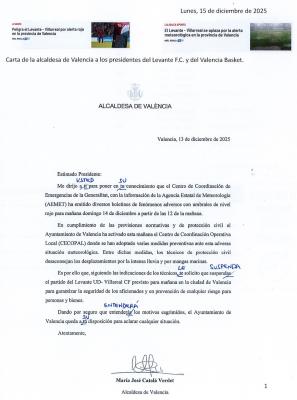Actividad de hoy en mi clase de español Carta de la alcaldesa de Valencia 13 diciembre 2025

Me suele gustar incorporar en mis clases de español temas de actualidad.
Creo que los profes de lenguas siempre miramos a nuestro alrededor buscando cosas que nos pueden ser de utilidad en el aula.
El sábado leyendo El Marca me encontré una noticia que decía:
¨Peligra el Levante - Villarreal por alerta roja en la provincia de Valencia¨.
Leyendo el artículo vi la carta que la alcaldesa de Valencia había escrito al presidente de La Liga y al presidente del Valencia Basket. Pensé: ¨genial, esto me va a venir de maravilla el lunes para explicar el formato de carta formal¨.
Cuando en el Bachillerato Internacional se evalúa una tarea escrita, en adquisición de lenguas, se tienen en cuenta los siguientes criterios:
A – Lengua: vocabulario y estructuras gramaticales correctas, comunicación eficaz.
B – Mensaje: ideas desarrolladas, claridad, organización.
C – Comprensión conceptual
En este último criterio se evalúa lo siguiente:
1.- ¨¿En qué medida la elección del tipo de texto es adecuada para la tarea?¨
Este es un ejemplo perfecto: carta formal, lugar, fecha, Estimado Presidente:, Atentamente, firma, posición. ¡Buen trabajo alcaldesa!
2.- ¨El registro y el tono son adecuados para el contexto, el propósito y los receptores de la tarea¨.
Lamento comunicarle, estimada alcaldesa, que si hubiera tenido que evaluar su carta, en este último criterio hubiera perdido bastantes puntos. No se puede tutear al presidente de La Liga ni al presidente del Valencia Basket. No se puede. Igual son sus coleguitas, no lo sé, pero desde su posición y firmando como alcaldesa de Valencia no lo puede hacer.
En clase les he entregado la carta a mis alumnos de secundaria, les he comentado el formato -perfecto- y luego les he preguntado a ver qué veían mal en ella y algún estudiante ha dicho ¨el registro¨. Con todos en la misma página, sabiendo en lo que tenían que centrarse, han corregido la carta de la alcaldesa.
--------------------
Es algo que estoy viendo más y más en España. La compañía de la luz, la de teléfono y otras organizaciones se dirigen a sus clientes tuteándolos con un colegueo inaceptable.


